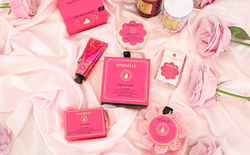In a world full of high-tech, electronic grooming gadgets, it's surprising that the old-fashioned straight-edge razor is still around. In fact, it is even more surprising that the straight-edge is actually making a huge comeback. This essential tool yields luxe results with its prestigious ability to provide the closest shave. Here is your complete guide on how to shave with a straight razor.
What Is a Straight Razor?
If you haven’t used a straight-edge razor, you’ve probably seen one at a barber’s shop shaving the beard of many men. A straight razor is a sharp single-blade razor attached to a handle, also known as the scale. The blade either folds to close, or a blade guard protects the sharp blade while not in use.
The blade on a straight razor consists of carbon steel, stainless steel, or Damascus steel material, and the blade and grip are held together by tiny pivot pins on the scale. These pins allow the blade to fold inside the handle, similar to how a pocket knife folds inside itself.
Straight edge blades come in many different blade lengths, widths, tip shapes, and consist of various metal materials. Some straight edge razors have decorative handles (scales) made of wood grain, ivory, gold, or ornate carvings. Barbers or hairdressers often store their straight-edge razor in a case or leather pouch for safekeeping.
How To Hold a Straight Razor
Hold the straight-edge razor with the hand you feel most comfortable with, usually your dominant hand. Place your thumb under the shank of the razor, then place your index, middle, and ring fingers on the opposite side of the shank (the top). Next, you’ll place the handle between your ring finger and the little finger. Finally, either the little finger or the ring finger rests on the crescent-shaped tang.
8 Steps: How To Shave With a Straight Razor
Shaving with a straight razor differs somewhat from traditional shaving with a standard razor. Pay close attention to these steps.
1. Skin Prep
As with any shaving procedure, you need to soften your skin and open the pores before beginning to shave. Prep your face by stepping into a hot shower for a few minutes, or apply a hot towel to your face.
The heat opens the pores on your skin and softens your skin. Make sure you prep your skin before every shave to ensure a close shave. After the hot shower, apply pre-shave oil to the area you’ll shave to soften your skin.
2. Hold Tight & Lather Up
If you’ve never used a straight razor before, you may find that using a transparent (clear) shave gel makes it easier to see where you’re placing the razor on your skin. Lather the shave gel you prefer to use onto your skin with a shaving brush. If you prefer to use a shave soap instead, place the soap in a shaving bowl and whisk it around with your brush. Then, apply the soap to your beard with the shaving brush.
Practice holding the razor blade in your dominant hand. How you grip the razor on your face is crucial for a safe, close shave. As you shave around your face and the corners of your mouth and nose, you need to adjust your grip. Here’s a quick run-through of what you’ll do:
- Grip the razor at a 30-degree angle from your face. If the razor is held too flat, it tears the whiskers, and if you hold it too steep, it cuts the skin.
- Pull your skin taut with the opposite hand you shave with, or stretch your neck.
- Apply gentle pressure with the blade. Gentle pressure assures you do not cut your face and fingers. Ouch!
3. First Move
Choose the side of the face you want to shave first. Begin shaving at the sideburn and move downward in the direction of your hair growth, using small, short strokes. Use the razor to stroke at a downward slant, starting at the top of your cheek near your ear. Move the razor in a short, even stroke without using chopping or jerking motions. Rinse the razor in hot water after each short stroke. Do not pull or drag the razor; the skin must remain taut to ensure a close shave without nicks.
4. Chin & Upper Lip
As you approach your chin, slightly lift the razor and use the middle part of the blade. Don’t ever begin a new stroke in a prominent area of your face, such as the chin or jaw. Begin just a bit away from these areas, and shave over them with more gentle, steady strokes. Approach each side of your upper lip in the same way you did the cheeks, with short, even strokes. Pull the opposite lip side taut to flatten that area of the skin. The center of the lip needs to be shaved separately by holding your nose upward to tighten the skin.
5. Lower Lip & Neck
To shave your lower lip, take the first stroke from the corner of your mouth across to the center of your chin. Then, use short, upward strokes to shave the hairs that remain. Start at the top of your chin, and allow the straight razor to follow the contours underneath your lip.
To avoid cuts and irritation on your neck, follow the grain of your hair on your neck when you shave that area. Your hair growth differs in different places, so use short and steady stokes and be careful.
6. Repeat
Most people that shave with a straight razor for the first time miss areas of hair on the first pass. If this happens, do a second pass and spot check for missed areas. Shave against or across the grain of the face on the second pass.
Just remember to splash your face with warm water first, then apply a re-lather or shave gel or shave cream. Never neglect the use of shaving cream. It protects your delicate skin by providing a cushion for your skin.
7. Moisturize the Skin
After you shave, it is extremely important to moisturize your skin to prevent bumps and dry skin. First, splash cold water on your skin to remove excess shave cream and tighten your pores. Then, apply a post-shave balm or moisturizer to your face. Pat the balm into your skin instead of massaging it to avoid skin irritation.
8. Clean-Up & Storage
Cleaning and storing your blade is important. Rinse the blade in warm water and wipe it with a clean cloth. The goal is to remove hair and other debris from the razor. Disinfect the razor with rubbing alcohol, then dry it again with a clean towel.
Clean the handle with a damp cloth, then store your razor in a cool, dry area. Some people rub camellia oil over the blade before storing it to prevent rust. Sharpen your razor as needed on a leather strop.
- Never use a rusty straight-edge razor, ever. Using a rusty or dull razor causes irritation, nicks, cuts, and irritated skin. It may also cause infections.
- Do not ever share your razors with another person. Sharing your razors with others is especially concerning if cuts occur. Blood spills spread bacteria and disease and cause the spread of illness, disease, and infections.
These are the eight steps to a straight razor shave.
Why Shave With a Straight Razor?
Straight razors provide you with a cleaner and closer shave than disposable and electric razors. This type of shaving reduces the chance of pesky razor burn and bumps, including ingrown hairs. It may cost more than disposable razors, but straight-edge razors are a one-time investment that pays for themselves. Your beard is history with just a few strokes of the blade.
Bottom Line
Shaving with a straight-edge razor is an experience that makes shaving enjoyable. The shave you get is closer and cleaner than any other shave with other razors. Once you master the grip of the razor and your preferred shaving products, you’ll be shaving like a pro in no time.
The Spongelle Men’s Collection includes luxe body buffers that offer a massive moisturizing lather for an invigorating clean. Kick-start your morning routine with black tea and coffee extracts blended with shea and mango butter packed into a portable sponge. It conveniently stows away in your gym bag or shower caddy for a triple threat clean. Cleanse, exfoliate, and hydrate in one punch with Spongelle.
Sources:
Hair removal: How to shave | American Academy of Dermatology
Tips for men: how to shave | American Academy of Dermatology















